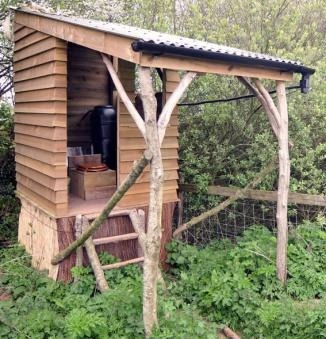Tree Bog
 A concept similar to the arborloo is the tree bog. In this case, bog refers to the British slang word for toilet. It doesn’t use a pit, thereby making it ideal for locations where flooding of the pit is a serious problem. Instead the structure is raised about three feet off the ground. Below it is an area left open to the air to encourage rapid decomposition. It is closed off by a double layer of netting filled with straw that allows air circulation but keeps out insects, larger animals, and children, and acts as a screen. The straw also acts as a wick to absorb excess urine. Waste simply collects in the open space below the structure.
A concept similar to the arborloo is the tree bog. In this case, bog refers to the British slang word for toilet. It doesn’t use a pit, thereby making it ideal for locations where flooding of the pit is a serious problem. Instead the structure is raised about three feet off the ground. Below it is an area left open to the air to encourage rapid decomposition. It is closed off by a double layer of netting filled with straw that allows air circulation but keeps out insects, larger animals, and children, and acts as a screen. The straw also acts as a wick to absorb excess urine. Waste simply collects in the open space below the structure.The main feature of this variation, however, is that the structure is surrounded by willows, nettles, and other nutrient-hungry plants. They enhance the composting by drawing off nutrients from the waste. Unlike other variations, a tree bog never needs to be emptied as long as the plants are actively growing. However, the high nitrogen content of the waste needs to be balanced by a high carbon source added to the mass, such as sawdust, straw, woodchips, ash, or bran. These also help to contain odors. The plants themselves may be harvested each year to recover some of the biomass obtained from the waste.
Published on December 28, 2013 04:42
•
Tags:
green-technology, sanitation, toilets, trees
No comments have been added yet.
Songs of the Seanchaí
Musings on my stories, the background of my stories, writing, and the world in general.
- Kevin L. O'Brien's profile
- 23 followers



